Downforce
Motor sports are all about maximum performance, to be the fastest is the absolute. There is nothing else.
To be faster you need power, but there is a limit to how much power you can put on the ground. To increase this limit, force to ground must be applied on the wheels. Increasing weight can do this, but weight makes handling worse and require more power. So we need some virtual weight, we call it downforce and get it from airflow around the car.
A wing can make a plane fly, but if we put it upside down, it can make a car NOT fly.
Typically the term "lift" is used when talking about any kind of aerodynamically induced force acting on a surface. This is then given an indicator, either "positive lift" (up) or "negative lift" (down) as to its direction. In aerodynamics of ground racing (cars, bikes, etc.) the term "lift" is generally avoided as its meaning is almost always implied as positive, i.e., lifting the vehicle off the track. The term "downforce", therefore, should always be implied as negative force, i.e., pushing the vehicle to the road.
Both the drag force and the downforce are proportional to the square of the velocity of a car. The drag force is given by:
|
Cd is the coefficient of drag determined by the exact shape of the car and its angle of attack.
The downforce is given by:
|
Cl is the coefficient of lift, again determined by the exact shape of the car
and its angle of attack. In the case of a modern Formula 1 car, the lift-to-drag ratio Cl/Cd has a typical value of, say, 2.5, so downforce dominates performance.
In current motor racing competitions, including Formula 1, DTM, Indy cars and Touring Car, aerodynamic downforce plays the most important role in the performance of the cars.
In the mid 1960's the use of soft rubber compounds and wider tires demonstrated that good road adhesion and hence cornering ability, was just as important as raw engine power in producing fast lap times.
The tire width factor came as something of a surprise. In sliding friction between hard surfaces, the friction resistance force is independent of the contact area (read about forensic science in braking here). It came as a similar surprise to find that the friction could be greater than the contact force between the two surfaces, apparently giving a coefficient greater than one. This would be similar to having glue on the tires, making them “stick” to the ground.
The desire to further increase the tire adhesion led the major revolution in racing car design, the use of negative lift or 'downforce'. Since the tires lateral adhesion is roughly proportional to the downloading on it, or the friction between tire and road, adding aerodynamic downforce to the weight component improves the adhesion. Downforce also allows the tires to transmit a greater thrust force without wheel spin, increasing the maximum possible acceleration. Without aerodynamic downforce to increase grip, modern racing cars have so much power that they would be able to spin the wheels even at speeds of more than 160 km/h.
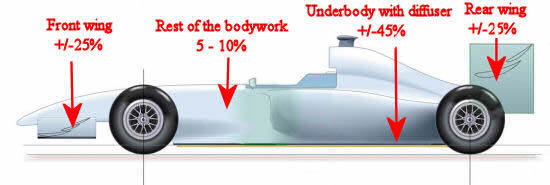
Downforce, or negative lift, pushes the car onto the track.
It is said that at maximum speed, an F1 car produces 5 g's of downforce! 5 times its weight pressing it down onto the track.
Produced by almost every part of F1 car but mostly by use of diffuser and wings in the way that longer cord lenght is facing downward.
Helping to induce more tire grip, but more downforce usually induce more drag.
Downforce has to be balanced between front and rear, left and right. We can easily achieve the balance between left and right by simple symmetry, so it will not be discussed. Front and rear is a different thing. Flow in the front greatly affects flow in the back of the car, and vice versa.
Downforce must be adjusted according to racing track and behavior of the car. To much front downforce induce oversteer. To much back downforce induce understeer. Variating downforce you can resolve the problems with oversteering or understeering car. Normally, with price of adding drag.
The success of these features relies primarily on the appropriate and efficient harnessing of drag and downforce - both of which are ruled by physical principles explained by Bernoulli's equation. Though Bernoulli's principle is a major source of lift or downforce in an aircraft or racing car wing, Coanda effect plays an even larger role in producing lift.
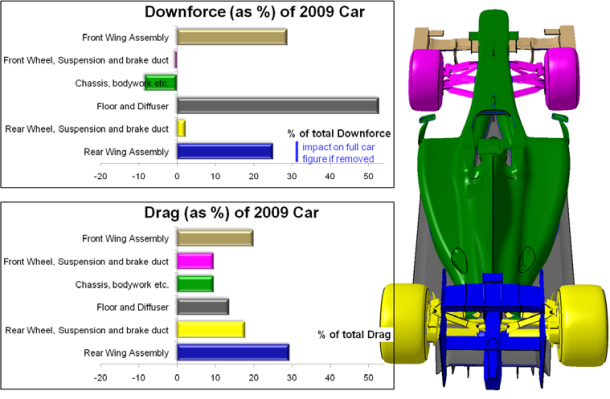 |
Insight into aerodynamics basics – downforce and drag breakdown into major components. (From "Aeronautical Journal Jan 2013", courtesy of Willem Toet, Head of Aerodynamics, Sauber F1 Team, Sauber Motorsport AG) |
In order to discuss lift and downforce, it may be helpful to provide an additional explanation of the relationship that occurs with the above form of Bernoulli's equation. If a fluid flows around an object at different speeds, the slower moving fluid will exert more pressure on the object than the faster moving fluid. The object will then be forced toward the faster moving fluid. A product of this event is either lift or downforce, each of which is dependent upon the positioning of the wing's longer chord length. Lift occurs when the longer chord length is upward and downforce occurs when it is downward. Longer chord alvays produce lover pressure.
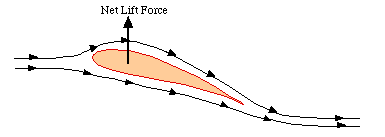 Lift
Lift
 Downforce
Downforce
As we explain before, all body surface can create downforce, and we can divide the car in three parts: front, middle and rear.
On rear, main source of downforce are rear spoilers, wings and diffuser. About wings you can read in separate article.
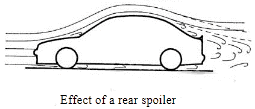
A spoiler is a simple plate placed somewhere on the car body so that it can interfere or “spoil” the flow around the vehicle, creating a controlled separation of the flow in a desired place. This is done because fast, smooth airflow leads to positive lift, so by spoiling this flow the lift is either reduced or maybe completely canceled out.
A rear spoiler is a plate in the rear of the vehicle and to be considered a spoiler, the plate must be integral with the body. If there’s a space between the plate and the body, then it it’s considered a wing. As can be seen in picture, the spoiler causes separation in the rear of the car, creating turbulence just before the flow, this turbulence causes the flow to move more slowly, therefore reducing the low pressure in the area just in front of this spoiler. Therefore, lift on the rear portion of the car is eliminated. Properly designed, a rear spoiler will create downforce on the rear part of the car.
Diffusers are, after wings, the most commonly seen devices to generate downforce in the rear portion of the racing vehicle. In them, we use the Bernoulli equation, much in the same way that we do with a venturi tube. In a venturi, we can see clearly that pressure and velocity squared are inversely proportional, so diffusers can help to reduce the pressure of the flow under the car by increasing its velocity.
On front of the car main source of downforce are front spoilers (called spoilers, dam or splitters), canards (called also dive plates), vortex generators, undertray with front diffuser.
The spoiler, dam or splitter are explained better if you follow the link. They reduces the gap between the ground and vehicle blocking most of the air that would go under the vehicle (sending it to the sides of the car). If the spoiler is utilized on a car that doesn't have a smooth underside, where the airflow is extremely turbulent, drag is greatly reduced since less air has to pass through all the elements in the bottom of the car, we can also expect to get a reduction in lift (and maybe a little downforce) in this case. Front splitter and spoiler are not exactly the same thing, but we will not go into the detail here.
Canards and vortex generators are explainer here in detail. These small fin like attachments to the front corners of the car. The inclination of these plates creates downforce on the front of the car, though in the small amount. The same devices can be used in other parts of the vehicle; however, care must be taken so that the leading edge vortices do not affect the operation of the rear wing or other aerodynamic devices. This dive plates are more trimming devices than anything else, they are too small to generate large amounts of downforce; instead, they are used to set up the vehicle handling before a race.
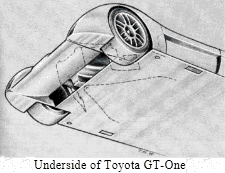 Undertray with front diffuser is almost exclusively used by LMP sport cars. LMP cars have a flat bottom, but the front of the car can have ducts to feed the engine and such. These ducts are used also to gain a certain downforce. As you can see in the image of a Toyota GT-One the front undertray of the vehicle is highly contoured, so that air coming under the car splits up, some of it going through to the rear of the car, but another part goes to the exits behind the front wheel.
Undertray with front diffuser is almost exclusively used by LMP sport cars. LMP cars have a flat bottom, but the front of the car can have ducts to feed the engine and such. These ducts are used also to gain a certain downforce. As you can see in the image of a Toyota GT-One the front undertray of the vehicle is highly contoured, so that air coming under the car splits up, some of it going through to the rear of the car, but another part goes to the exits behind the front wheel.
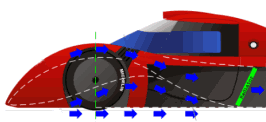 This flow, goes upward into a diffuser like compartment, where it’s pressure is reduced, thus generating downforce just ahead of the front axle. The effect is basically the same as an air dam, but here the flow is also directed towards the sides and the splitter that marks the beginning of the flat floor. For more info check my article about diffuser.
This flow, goes upward into a diffuser like compartment, where it’s pressure is reduced, thus generating downforce just ahead of the front axle. The effect is basically the same as an air dam, but here the flow is also directed towards the sides and the splitter that marks the beginning of the flat floor. For more info check my article about diffuser.
On middle of the car, main source of downforce are side skirts, side ducts and vortex generators. They are explained in my articles i detail, just follow the links!
 |
Jackie Stewart won three times at the Nurburgring. Flight like this, with all downforce Formula 1 have, today is not possible |
Just as the conclusion we can say that air flow cannot be divided, what happens in one-part affects what happens in another. Therefore, a front spoiler will affect a rear diffuser and vice versa. We must be careful with air flow and how we using it.
Front spoilers are used to reduce flow to the bottom of the car; this is very desirable when the car does not have a smooth underside with a diffuser or other arrangement, simply for the drag reduction obtained. However, if we have a flat underside, it is actually worse to have a spoiler in the front. The smooth underside requires a big amount of air to be really effective, so a spoiler here would reduce the quantity of the air and will not be desired. However, there are cases where we can see some small spoiler applied, the reasons for it can go from some specific aerodynamic design feature to simple ignorance.
A diffuser is used to increase flow rate in the bottom of the car, since there is a limit into how much air we can suck down there from the front, air will try and come from the sides, some times we can use this to our advantage, sometimes we don’t. This is why some cars use skirts. Front spoiler or dam will most certainly destroy work of diffuser. Front vortex generator will help.
We usually do not talk about wings in this article, since we are trying to avoid their use. However in practically all classes of racecars, we can find a front or rear wing. This is due to their easy adjustability, something that is impossible with an underbody. So we are probably going to have a wing, this wing has to receive rather steady flow for it to work, so we must be careful that the car body is able to provide it. Also, the wing will affect the performance of a diffuser, if it is close enough. This is desirable, since the wings effect can usually increase the rate flow from the diffuser to the car’s wake.
So, how much force Formula 1 car can generate?
- Following the basic laws of physics, aerodynamic forces increase with the square of speed. That means twice the speed, four times the force.
- There has been lots of talk about the downforce generated by Formula 1 cars but none of the modern cars generate as much as the best cars of the early 1994. regulation cars.
- None the less, the cars do generate many times their own weight in downforce at speed and equal their own weight by just under 100 mph.






